Jan Ijäs’ Two Wars is a documentary essay film in two parts. The first concerns a prisoner-of-war camp in Monte Cassino, where the Austrian philosopher Ludwig Wittgenstein, who fought in WWI, finished his book Tractatus Logico-Philosophicus. In the book, Wittgenstein presents his picture theory of language. According to the theory, sentences are like pictures whose components constitute a picture depicting a state of affairs in the real world. The theory exemplifies the so-called correspondence theory of truth, which maintains that sentences are true if they correspond to states of affairs. The second part of the film concerns the village of San Pietro Infine, where the famous Battle of San Pietro took place during WWII. The American film director John Huston depicts the battle in his documentary San Pietro (1945). For a long time, the film had a reputation as an authentic depiction of the battle, but in reality, the battles shown in it were staged after the actual events.
In Ijäs’ film, Wittgenstein’s picture theory thinking is put in dialogue with Huston’s cinematic lying. When a reality corresponding to linguistic depictions is nowhere to be found, it must be imagined. Two Wars is an essayistic reflection on art and truthlikeness, audiovisual representation and its falsehood, as well as the senselessness of wars.
Two Wars will be screened before San Pietro by John Huston.
Ilpo Hirvonen
